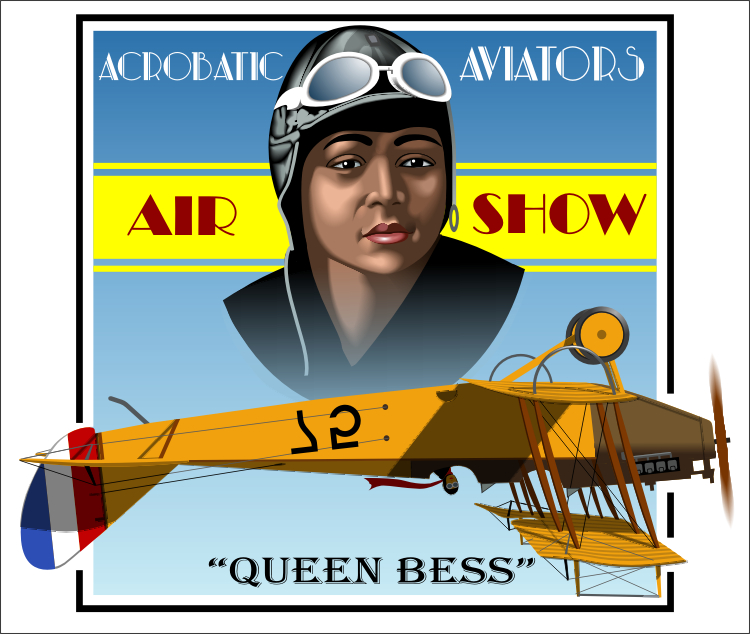
BESSIE COLEMAN
|
Bessie Coleman was born on January 26, 1892, in Atlanta, Texas, from George Coleman, who was mostly Cherokee and part African-American, and Susan, who was African-American. She was the first woman of African American descent, and the first of Native American descent, to hold a pilot license. This despite the fact that the US women, either white and black, didn't have this right. I therefore believe that her history is worthy of note, even confined to basic developments. She is one more model of courage and determination, likewise those women who managed to gain a foothold in the society thanks to their person's identity, not slaves or subordinate to the reigning machismo. Born to a family of sharecroppers in Texas, as soon as she completed the first grade in a segregated, one-room school, she started to work into the cotton fields. In 1916 at the age of 23, she moved to Chicago, Illinois, where she worked as a manicurist at the 'White Sox Barber Shop'. There she heard stories from pilots returning home from World War I about flying during the war. From those stories arises her passion for the flight, which will last till the end of her short life. She used to think and say that air was the only place without prejudices against women or blacks. And, to this end, it was her duty to even may risk her life in order to learn how to fly. Unfortunately american flight schools admitted neither women nor blacks, and Robert S. Abbott, founder and publisher of the Chicago Defender, encouraged her to study abroad. Coleman received financial backing from banker Jesse Binga and the Defender. She traveled to Paris on November 20, 1920. She learned to fly in a Nieuport 82 biplane, in fact a four-wheeled wagon named 'Le Grand Julie', and could earn her pilot license. She became a "barnstorming" stunt flier thanks to the personal concern of the german Anthony Fokker. She then returned to the United States to launch her career in exhibition flying with Curtiss JN-4 "Jenny" biplanes. "Queen Bess," as she was known, was a highly popular draw for the next five years, admired by both blacks and whites. The press billed Coleman as "the world's greatest woman flier". Coleman would not live long enough to establish a school for young black aviators but her pioneering achievements served as an inspiration for a generation of African American men and women. "Because of Bessie Coleman," wrote Lieutenant William J. Powell in Black Wings 1934, dedicated to Coleman, "we have overcome that which was worse than racial barriers. We have overcome the barriers within ourselves and dared to dream." Bessie Coleman died in a downing of flight in Jackonville, Florida in April 30, 1926. Although the wreckage of the plane was badly burned, it was later discovered that a wrench used to service the engine had jammed the controls. Coleman was 34 years old. Bessie hasn't been forgotten: -A public library in Chicago was named in Coleman's honor, as are roads at O'Hare International Airport in Chicago, Oakland International Airport in Oakland, California, Tampa International Airport in Florida, and at Germany's Frankfurt International Airport. -A memorial plaque has been placed by the Chicago Cultural Center at the location of her former home, 41st and King Drive in Chicago, and it is a tradition for African American aviators to drop flowers during flyovers of her grave at Lincoln Cemetery. -A roundabout leading to Nice Airport in the South of France was named after her in March 2016. -Bessie Coleman Middle School in Cedar Hill, Texas is named for her. -Bessie Coleman Boulevard in Waxahachie, Texas where she lived as a child is named in her honor. -B. Coleman Aviation, a fixed-base operator based at Gary/Chicago International Airport, is named in her honor. -Several Bessie Coleman Scholarship Awards have been established for high school seniors planning careers in aviation. -The U.S. Postal Service issued a 32-cent stamp honoring Coleman in 1995. -The Bessie Coleman Commemorative is the 18th in the U.S. Postal Service Black Heritage series. -In 2006, she was inducted into the National Aviation Hall of Fame. -In 2012, a bronze plaque with Coleman's likeness was installed on the front doors of Paxon School for Advanced Studies located on the site of the Jacksonville airfield where Coleman's fatal flight took off. -Coleman was honored with a toy character in season 5, episode 11a of the children's animated television program Doc McStuffins. -She was placed No. 14 on Flying's 2013 list of the "51 Heroes of Aviation". -On January 25, 2015, Orlando renamed West Washington Street to recognize the street's most accomplished resident. -On January 26, 2017, the 125th anniversary of her birth, a Google Doodle was posted in her honor. For years, in the anniversary of her death, black fliers used to fly above her grave, laying flowers on it. |
